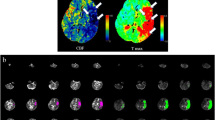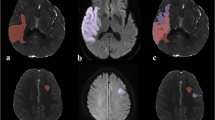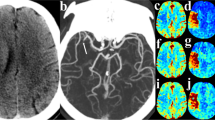Abstract
Introduction
We aimed to determine if volumetric mismatch between tissue at risk and tissue destined to infarct on computed tomography perfusion (CTP) can be described by the mismatch of Alberta Stroke Program Early CT Score (ASPECTS).
Materials and methods
Forty patients with nonlacunar middle cerebral artery infarct <6 h old who had CTP on admission were retrospectively reviewed. Two raters segmented the lesion volume on mean transit time (MTT) and cerebral blood volume (CBV) maps using thresholds of >6 s and <2.0 mL per 100 g, respectively. Two other raters assigned ASPECTS to the same MTT and CBV maps while blinded to the volumetric data. Volumetric mismatch was deemed present if ≥20%. ASPECTS mismatch (=CBV ASPECTS − MTT ASPECTS) was deemed present if ≥1. Correlation between the two types of mismatches was assessed by Spearman’s coefficient (ρ). ROC curve analyses were performed to determine the optimal ASPECTS mismatch cut point for volumetric mismatch ≥20%, ≥50%, ≥100%, and ≥150%.
Results
Median volumetric mismatch was 130% (range 10.9–2,031%) with 31 (77.5%) being ≥20%. Median ASPECTS mismatch was 2 (range 0–6) with 26 (65%) being ≥1. ASPECTS mismatch correlated strongly with volumetric mismatch with ρ = 0.763 [95% CI 0.585–0.870], p < 0.0001. Sensitivity and specificity for volumetric mismatch ≥20% was 83.9% [95% CI 65.5–93.5] and 100% [95% CI 65.9–100], respectively, using ASPECTS mismatch ≥1. Volumetric mismatch ≥50%, ≥100%, and ≥150% were optimally identified using ASPECTS mismatch ≥1, ≥2, and ≥2, respectively.
Conclusion
On CTP, ASPECTS mismatch showed strong correlation to volumetric mismatch. ASPECTS mismatch ≥1 was the optimal cut point for volumetric mismatch ≥20%.




Similar content being viewed by others
References
Hacke W, Albers G, Al-Rawi Y et al (2005) The Desmoteplase in Acute Ischemic Stroke Trial (DIAS): a phase II MRI-based 9-hour window acute stroke thrombolysis trial with intravenous desmoteplase. Stroke 36:66–73
Albers GW, Thijs VN, Wechsler L et al (2006) Magnetic resonance imaging profiles predict clinical response to early reperfusion: the diffusion and perfusion imaging evaluation for understanding stroke evolution (DEFUSE) study. Ann Neurol 60:508–517
Butcher KS, Parsons M, MacGregor L et al (2005) Refining the perfusion–diffusion mismatch hypothesis. Stroke 36:1153–1159
Butcher K, Parsons M, Allport L et al (2008) Rapid assessment of perfusion–diffusion mismatch. Stroke 39:75–81
Barber PA, Demchuk AM, Zhang J et al (2000) Validity and reliability of a quantitative computed tomography score in predicting outcome of hyperacute stroke. Lancet 355:1670–1674
Pexman JH, Barber PA, Hill MD et al (2001) Use of the Alberta Stroke Program Early CT Score (ASPECTS) for assessing CT scans in patients with acute stroke. AJNR Am J Neuroradiol 22:1534–1542
Wintermark M, Meuli R, Browaeys P et al (2007) Comparison of CT perfusion and angiography and MRI in selecting stroke patients for acute treatment. Neurology 68:694–697
Sanelli PC, Lev MH, Eastwood JD et al (2004) The effect of varying user-selected input parameters on quantitative values in CT perfusion maps. Acad Radiol 11:1085–1092
Newcombe RG (1998) Two-sided confidence intervals for the single proportion: comparison of seven methods. Stat Med 17:857–872
Coutts SB, Lev MH, Eliasziw M et al (2004) ASPECTS on CTA source images versus unenhanced CT: added value in predicting final infarct extent and clinical outcome. Stroke 35:2472–2476
Aviv RI, Shelef I, Malam S et al (2007) Early stroke detection and extent: impact of experience and the role of computed tomography angiography source images. Clin Radiol 62:447–452
Camargo EC, Furie KL, Singhal AB et al (2007) Acute brain infarct: detection and delineation with CT angiographic source images versus nonenhanced CT scans. Radiology 244:541–548
Parsons MW, Pepper EM, Chan V et al (2005) Perfusion computed tomography: prediction of final infarct extent and stroke outcome. Ann Neurol 58:672–679
Aviv RI, Mandelcorn J, Chakraborty S et al (2007) Alberta Stroke Program early CT scoring of CT perfusion in early stroke visualization and assessment. AJNR Am J Neuroradiol 28:1975–1980
Kloska SP, Dittrich R, Fischer T et al (2007) Perfusion CT in acute stroke: prediction of vessel recanalization and clinical outcome in intravenous thrombolytic therapy. Eur Radiol 17:2491–2498
Lin K, Rapalino O, Law M et al (2008) Accuracy of the Alberta Stroke Program Early CT Score during the first 3-hours of middle cerebral artery stroke: comparison of noncontrast CT, CT angiography source images, and CT perfusion. AJNR Am J Neuroradiol 29:931–936
Barber PA, Hill MD, Eliasziw M et al (2005) Imaging of the brain in acute ischaemic stroke: comparison of computed tomography and magnetic resonance diffusion-weighted imaging. J Neurol Neurosurg Psychiatry 76:1528–1533
The National Institute of Neurological Disorders and Stroke (NINDS) rt-PA Stroke Study Group (2000) Effect of intravenous recombinant tissue plasminogen activator on ischemic stroke lesion size measured by computed tomography NINDS. Stroke 31:2912–2919
Wintermark M, Reichhart M, Cuisenaire O et al (2002) Comparison of admission perfusion computed tomography and qualitative diffusion- and perfusion-weighted magnetic resonance imaging in acute stroke patients. Stroke 33:2025–2031
Eastwood JD, Lev MH, Wintermark M et al (2003) Correlation of early dynamic CT perfusion imaging with whole-brain MR diffusion and perfusion imaging in acute hemispheric stroke. AJNR Am J Neuroradiol 24:1869–1875
Phan TG, Donnan GA, Koga M et al (2006) The ASPECTS template is weighted in favor of the striatocapsular region. Neuroimage 31:477–481
Mori S, Obata T, Nakajima N et al (2005) Volumetric perfusion CT using prototype 256-detector row CT scanner: preliminary study with healthy porcine model. AJNR Am J Neuroradiol 26:2536–2541
Wintermark M, Flanders AE, Velthuis B et al (2006) Perfusion-CT assessment of infarct core and penumbra: receiver operating characteristic curve analysis in 130 patients suspected of acute hemispheric stroke. Stroke 37:979–985
Takasawa M, Jones PS, Guadagno JV et al (2008) How reliable is perfusion MR in acute stroke? Validation and determination of the penumbra threshold against quantitative PET. Stroke 39:870–877
Bristow MS, Simon JE, Brown RA et al (2005) MR perfusion and diffusion in acute ischemic stroke: human gray and white matter have different thresholds for infarction. J Cereb Blood Flow Metab 25:1280–1287
Parsons MW, Barber PA, Chalk J et al (2002) Diffusion- and perfusion-weighted MRI response to thrombolysis in stroke. Ann Neurol 51:28–37
Thijs VN, Adami A, Neumann-Haefelin T et al (2001) Relationship between severity of MR perfusion deficit and DWI lesion evolution. Neurology 57:1205–1211
Schaefer PW, Roccatagliata L, Ledezma C et al (2006) First-pass quantitative CT perfusion identifies thresholds for salvageable penumbra in acute stroke patients treated with intra-arterial therapy. AJNR Am J Neuroradiol 27:20–25
Kidwell CS, Alger JR, Saver JL (2003) Beyond mismatch: evolving paradigms in imaging the ischemic penumbra with multimodal magnetic resonance imaging. Stroke 34:2729–2735
Christensen S, Parsons MW, DeSilva D et al (2008) Optimal mismatch definitions for detecting treatment response in acute stroke. Abstract presented at the 17th European Stroke Conference, Nice, France May 13–16, 2008
Kakuda W, Lansberg MG, Thijs VN et al (2008) Optimal definition for PWI/DWI mismatch in acute ischemic stroke patients. J Cereb Blood Flow Metab. 28:887–891
Weir NU, Pexman JH, Hill MD et al (2006) How well does ASPECTS predict the outcome of acute stroke treated with IV tPA. Neurology 67:516–518
Conflict of interest statement
We declare that we have no conflict of interest.
Author information
Authors and Affiliations
Corresponding author
Rights and permissions
About this article
Cite this article
Lin, K., Rapalino, O., Lee, B. et al. Correlation of volumetric mismatch and mismatch of Alberta Stroke Program Early CT Scores on CT perfusion maps. Neuroradiology 51, 17–23 (2009). https://doi.org/10.1007/s00234-008-0454-y
Received:
Accepted:
Published:
Issue Date:
DOI: https://doi.org/10.1007/s00234-008-0454-y




